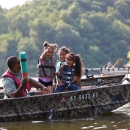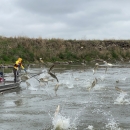Species that are considered high risk have a well-documented history of invasiveness in at least one location globally, and a high or medium climate match to the contiguous United States.
Cherax quadricarinatus is a crayfish native to northeastern Australia that has become popular in the aquaculture and aquarium industries. It has become established in Asia, Africa, South America, North America, and the Caribbean. Economic impacts of these introductions may benefit some people but harm others, as C. quadricarinatus populations have become important to local economies in Jamaica and Mexico when native shrimp decline; however, that decline may be due to the crayfish. The crayfish harm artisanal fishing in the Kafue Flats of Zambia by damaging fish caught in gill nets and damaging the nets themselves. C. quadricarinatus is a vector for OIE-reportable pathogens and parasites that cause disease, notably white spot syndrome virus (WSSV) and crayfish plague. WSSV caused heavy mortality in Louisiana crayfish farms during a 2007 outbreak, and although North American species of crayfish are less susceptible to crayfish plague than crayfish native to other continents, there is evidence of disease and mortality in native crayfish under high-stress conditions. C. quadricarinatus may not establish if introduced into the United States where crayfish plague is present in the environment; C. quadricarinatus is established in Puerto Rico and reported in southern California. Introduced C. quadricarinatus populations show an inverse relationship with a native crab population in Singapore and native crayfish populations in New South Wales, Australia, i.e., large introduced crayfish were associated with smaller or absent native species. The climate match indicates a medium match with the contiguous United States, with high matches in Texas and South Florida. Overall risk is high.



